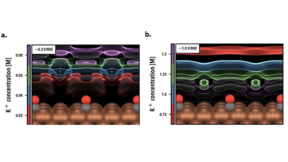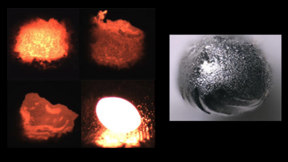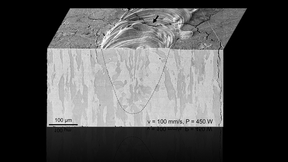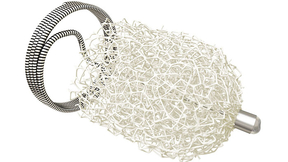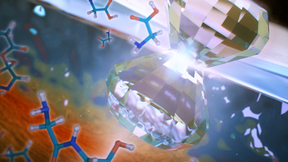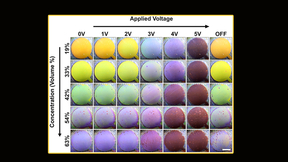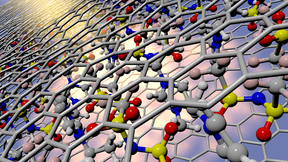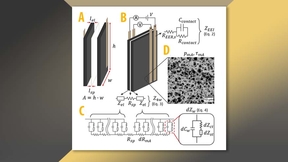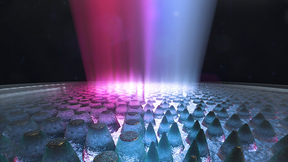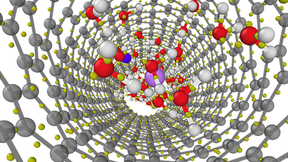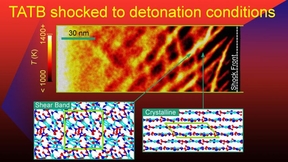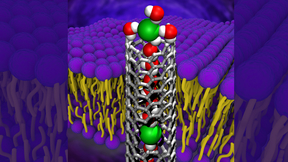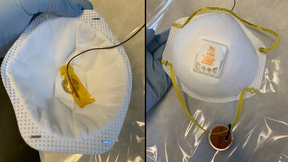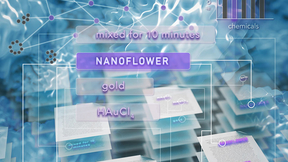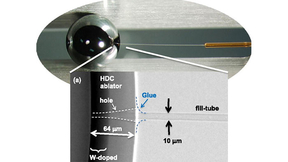Back
Advanced Materials and Manufacturing
Addressing electrolyte composition effects in CO2 electroreduction
The electrochemical conversion of CO2 into chemical fuels and other commodity products is an attractive strategy for mitigating carbon emissions while offsetting the use of fossil resources. Nevertheless, the adoption of such approaches in industrial settings has been limited by the poor efficiency and selectivity of the electrochemical cells that are used to drive CO2…
Formation of high-purity uranium via laser-induced thermal decomposition
Producing gram quantities of uranium metal in a controlled manner by traditional methods is challenging due to the complex chemistry of precursor material and extreme thermal requirements. In a recent study, LLNL researchers demonstrated a novel approach that combines modeling and an advanced experimental technique for extracting uranium from a uranium-containing compound…
Simulations, high-speed videos help researchers see crack formation in 3D-printed tungsten in real time
Boasting the highest melting and boiling points of all known elements, tungsten has become a popular choice for applications involving extreme temperatures, including lightbulb filaments, arc welding, radiation shielding and, more recently, as plasma-facing material in fusion reactors such as the ITER Tokamak. However, tungsten’s inherent brittleness, and the microcracking…
Lab steps on the gas to enhance chemical production
To optimize catalyst performance, a team of scientists from Lawrence Livermore National Laboratory (LLNL) and collaborators has developed a detailed understanding of the effect of pretreatment-induced nanoscale structural and compositional changes on catalyst activity and long-term stability. The research could make the production of the important industrial feedstock…
Wheels keep turning on innovations for clean vehicles
The Co-Optima FY19 Year in Review report released by the U.S. Department of Energy (DOE) describes recent accomplishments to improve efficiency while reducing emissions and cost for the entire on-road fleet of combustion-powered vehicles under the Co-Optimization of Fuels & Engines program. Lawrence Livermore National Laboratory (LLNL) is playing a key role in this…
R&D 100 Winner: Expanding Embolization Success
Scientists from Livermore and Texas A&M University, along with California-based startup Shape Memory Medical, Inc., have improved upon existing technologies with the IMPEDE® embolization plug, winner of a 2019 R&D 100 Award.
Compressive shearing may start life on other planets
Massive compressive shearing forces generated by the tidal pull of Jupiter-like planets on their rocky ice-covered moons may form a natural reactor that drives simple amino acids to polymerize into larger compounds. These extreme mechanical forces strongly enhance molecule condensation reactions, opening a new arena of possibilities for the chemical origins of life on…
LLNL researchers achieve greater understanding of color origins in low-power electronic displays
Today’s low-power, electronic ink displays such as e-book readers produce text through a process called electrophoretic deposition (EPD). Each pixel of the display contains charged black and white particles suspended in a liquid solvent. These particles are moved by electrodes embedded in the devices, causing particles to stick to the electrodes to form words or images…
3D nanometer-thin membrane borrows from biology
Mimicking the structure of the kidney, a team of scientists from Lawrence Livermore National Laboratory (LLNL) and the University of Illinois at Chicago (UIC) have created a three-dimensional nanometer (nm)-thin membrane that breaks the permeance-selectivity trade-off of artificial membranes. Highly permeable and selective membranes are useful for a wide range of…
Diving into the structure of molten salts in tight spaces
Room temperature ionic liquids (ILs), a special class of molten salts, promise far greater electrochemical performance compared to conventional aqueous solutions due to a suite of novel and tunable properties. Over the past two decades, ILs have been explored as a means of improving a range of different technologies, from energy storage and conversion to catalysis to…
Summer students shine in desalination research
Capacitive deionization (CDI) is an emerging class of water desalination technologies that use cyclic charging and discharging of electrodes to reduce or enrich the salinity of incoming water. The desalination characteristics of CDI are strongly influenced by the resistive components of the system. To better understand this process, a team of Lawrence Livermore National…
Researchers Develop Novel Antireflective Metasurface for Laser Optics
LLNL scientists have discovered a new method to add an antireflective metasurface layer on laser optics glass.
Pinpointing the effects of nanoconfinement on water
Researchers have spent decades studying the properties of water and how they change when there are disruptions to their normal behavior. Research on the topic has a wide range of applications, from biochemical systems to water desalination. A team of scientists from Lawrence Livermore National Laboratory (LLNL), Argonne National Laboratory and the University of Chicago…
Simulations explain detonation properties in TATB
Two Lawrence Livermore National Laboratory (LLNL) scientists have discovered a new mechanism for ignition of high explosives that explains the unusual detonation properties of 1,3,5-triamino-2,4,6-trinitrobenzene (TATB). The research will allow for systematic improvements to continuum mechanics models used to assess the performance and safety of the material accurately and…
AI identifies change in microstructure in aging materials
Lawrence Livermore National Laboratory (LLNL) scientists have taken a step forward in the design of future materials with improved performance by analyzing its microstructure using AI. The work recently appeared online in the journal Computational Materials Science. Technological progress in materials science applications spanning electronic, biomedical, alternate energy,…
Membrane nanopore transport gets picky
Trying to determine how negatively charged ions squeeze through a carbon nanotube 20,000 times smaller than a human hair is no easy feat. Not only did Lawrence Livermore National Laboratory (LLNL) scientists do that but they found that those ions are unexpectedly picky depending on the anion (a negatively charged ion). The research appears in ACS Nano. Inner pores of…
Deactivating coronavirus on N95 respirators for reuse
Lawrence Livermore National Laboratory (LLNL) researchers are studying ways to safely and rapidly remove viral threats from N95 respirators, without compromising the device’s fit and its ability to filter airborne particles, so they can be reused. As seen during the COVID-19 pandemic, a shortage of personal protective equipment, including surgical masks and respirators,…
Building scientific insight through machine learning
A team of Lawrence Livermore National Laboratory (LLNL) materials and computer scientists developed machine learning tools that extract and structure information from the text and figures of nanomaterials articles using state-of-the-art natural language processing, image analysis, computer vision and visualization techniques. They are applying this technique to COVID-19…
Lab devises plan to reduce defects in 3D metal printing
Combining high-fidelity computer simulations with ultra-high-speed X-ray imaging, researchers at Lawrence Livermore National Laboratory (LLNL) have discovered a strategy for reducing or even eliminating defects in parts built through a common, laser-based metal 3D-printing process. In work published by the journal Science, a research team at LLNL, along with collaborators…
Angled Fill-Tubes Aid Quest to Raise NIF’s Implosion Performance
The tiny fill-tube used to inject NIF’s high-density carbon capsules with cryogenic fuel is also known to reduce the performance of implosions, and LLNL researchers are exploring several methods that could diminish these negative effects.


